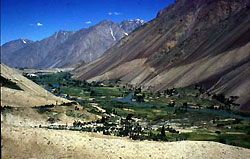| 1. From a Village in the Karakoram Range
Until the early 1970s, the region was governed by indigenous rulers called the Raja or Mehtar. Even after the establishment of Pakistan in 1947, they mediated disputes within their domains and collected annual tributes. It seems to make sense that the Karakorams remained an “untrodden region” to many Pakistanis only until recently. Though the raja system was abolished, the Pakistani government failed to establish an effective administrative presence in place of the old system. Freed from the “yoke of tradition,” people in the region naturally began to demand access to “modern institutions” such as schools, hospitals and courts. However, what they discovered was “institutional vacuum” that left them frustrated. The Aga Khan Foundation undertakes activities to fill this type of gap. Various organizations affiliated with it are proactively pushing projects related to education, medical care, rural development and architectural culture. The activities of this internationally renowned development NGO, as a matter of fact, are closely connected with the restoration of the Ismailis (a sect of the Islamic Shiite), many of whom live in the Karakoram Range. The Aga Khan Foundation is not the only NGO whose activities take advantage of the vitality of religious or ethnic groups. Exploring the vitality induced by religion or ethnicity in the context of the whole of Pakistan is my current research subject. Through this research, I would like to better understand the widening social impact of the activities of ethnic/religious groups, which tend to be seen negatively as impediments to national cohesion. NEJIMA Susumu |
